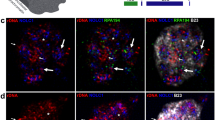Summary
This report describes cytological features of meiosis in Saccharomyces cerevisiae prepared for electron microscopy by lysis of protoplasts or nuclei on an aqueous surface. Whereas the chromatin of cells lysed before or after meiotic prophase was widely dispersed, pachytene bivalents appeared as discrete, elongate masses of compact chromatin. These bivalents were of nearly uniform thickness; they ranged in length from about 0.6 μm to 4.0 μm, with a median of 1.6–1.8 μm. Enzymatic digestion of chromosomal DNA removed the chromatin to reveal the underlying synaptonemal complex. The lysis of partially purified nuclei was less disruptive and thereby revealed the regular association of the telomeres with fragments of the nuclear envelope. In tetraploid cells, pachytene lysates contained quadrivalents characterized by the close apposition of chromatin masses of similar length. One or more points of intimate association appear to represent sites of exchange between pairing partners. The departure of the diploid cells from pachytene was accompanied by the renewed association of spindle microtubules with the chromosomes shortly before the diplotene chromosomes decondensed. Later, the successive meiotic divisions were identified by the appearance of a single spindle for meiosis I and of two spindles for meiosis II.
Similar content being viewed by others
References
Burkholder GD (1975) The ultrastructure of G- and C-banded chromosomes. Exp Cell Res 90: 269–278
Byers B, Goetsch L (1975) Electron microscopic observation on the meiotic karyotype of diploid and tetraploid Saccharomyces cerevisiae. Proc Natl Acad Sci USA 72: 5056–5060
Byers B, Goetsch L (1982) Reversible pachytene arrest of Saccharomyces cerevisiae at elevated temperature. Mol Gen Genet 187: 47–53
Comings DE (1978) Mechanisms of chromosome banding and implications for chromosome structure. Annu Rev Genet 12: 25–46
Counce SJ, Meyer GF (1973) Differentiation of the synaptonemal complex and the kinetochore in Locusta spermatocytes studied by whole mount electron microscopy. Chromosoma 44: 231–253
Esposito MS, Esposito RE (1978) Aspects of the genetic control of meiosis and ascospore development inferred from the study of spo (sporulation-defective) mutants of Saccharomyces cerevisiae. Biol Cell 33: 92–102
Klein HL, Byers B (1978) Stable denaturation of chromosomal DNA from Saccharomyces cerevisiae during meiosis. J Bacteriol 134: 629–635
Moens PB, Rapport E (1971a) Spindles, spindle plaques, and meiosis in the yeast Saccharomyces cerevisiae (Hansen). J Cell Biol 50: 344–361
Moens PB, Rapport E (1971b) Synaptic structures in the nuclei of sporulating yeast, Saccharomyces cerevisiae (Hansen). J Cell Sci 9: 665–677
Mortimer RK, Hawthorne DC (1975) Genetic mapping in yeast. Methods Cell Biol 11: 221–233
Moses MJ (1977) Synaptonemal complex karyotyping in spermatocytes of the Chinese hamster (Cricetalus griseus). I. Morphology of the autosomal complement in spread preparations. Chromosoma 60: 99–125
Moses MJ, Solari AJ (1976) Positive contrast staining and protected drying of surface spreads: electron microscopy of the synaptonemal complex by a new method. J Ultrastruct Res 54: 109–114
Peterson JB, Ris H (1976) Electron microscopic study of the spindle and chromosome movement in the yeast Saccharomyces cerevisiae. J Cell Sci 22: 219–242
Roman H, Phillips MM, Sands SM (1955) Studies of polyploid Saccharomyces. I. Tetraploid segregation. Genetics 40: 546–561
Solari AJ, Moses MJ (1977) Synaptonemal complexes in a tetraploid mouse spermatocyte. Exp Cell Res 108: 464–467
Westergaard M, von Wettstein D (1972) The synaptonemal complex. Annu Rev Genet 6: 71–110
Williamson DH, Fennell DJ (1981) Non-random assortment of sister chromatids in yeast mitosis. In: von Wettstein D, et al. (eds) Molecular genetics in yeast, Alfred Benzon Symposium, vol 16. Mumksgaard, Copenhagen, pp 89–100
Wintersberger U, Binder M, Fischer P (1975) Cytogenetic demonstration of mitotic chromosomes in the yeast Saccharomyces cerevisiae. Mol Gen Genet 142: 13–17
Wintersberger U, Smith P, Letnansky K (1973) Yeast chromatin. Preparation from isolated nuclei, histone composition and transcription capacity. Eur J Biochem 33: 123–130
Zickler D, Olson LW (1975) The synaptonemal complex and the spindle plaque during meiosis in yeast. Chromosoma 50: 1–23
Author information
Authors and Affiliations
Additional information
Communicated by G. Fink
Rights and permissions
About this article
Cite this article
Goetsch, L., Byers, B. Meiotic cytology of Saccharomyces cerevisiae in protoplast lysates. Molec. Gen. Genet. 187, 54–60 (1982). https://doi.org/10.1007/BF00384383
Received:
Issue Date:
DOI: https://doi.org/10.1007/BF00384383




